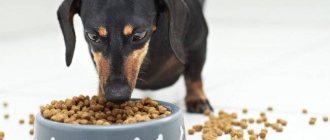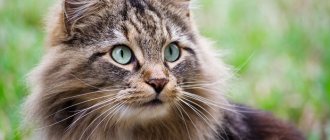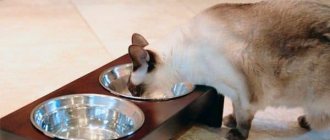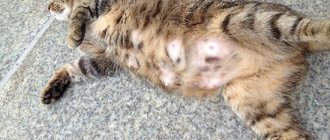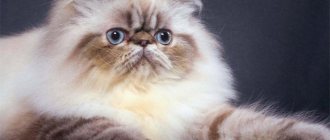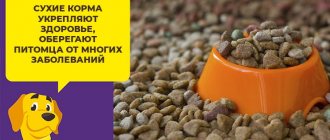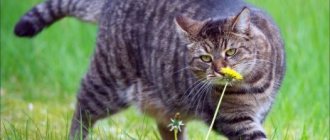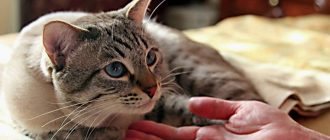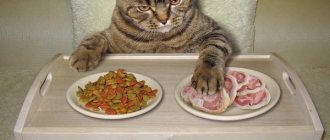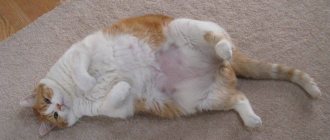4060Pavel
Let's figure out what is better, dry food or natural. For cats, it is not so difficult to choose the right diet. The main thing is to decide what you plan to feed your pet. In any case, whatever its nutrition, the main thing is that the cat receives with it the minimum necessary set of vitamins and useful elements for good health: amino acids, phosphorus, calcium, protein and others.
When feeding, you should maintain the correct balance, i.e., make sure that the animal receives nutrients in the required quantity, since a lack of them in the body or an imbalance when the cat receives an excessive amount of useful elements can have a very negative impact on health.
© shutterstock
If earlier, many veterinarians recommended giving only natural food to cats, today, thanks to many studies, it has been proven that what is important for an animal is not what kind of food it receives, dry or natural, but how high-quality and healthy it is. After all, both natural food and dry food can cause harm.
Economy cat food
Despite the fact that economy class food is actively advertised on television, showing us a cheerful and healthy cat Boris or Felix, this food’s composition cannot satisfy the animals’ needs for essential nutrients.
Economy class food contains only 4-6% meat products, but not meat. It is made from vegetable protein with a small addition of substrate from meat industry waste: leather, horns, hooves. When reading the ingredients, pay attention to which foods appear first on the ingredients line. In economy feeds, these can be cheap fillers: corn, soy, starch, wheat. These foods also contain preservatives, flavor enhancers, and dyes. Often manufacturers do not indicate them on the packaging.
List of economy class cat food
Economy foods include: All Cats, Cat Chow, Chammy, Darling, Felix, Friskies, Gemon, Gourmet, Perfect Fit, PreVital, Prokhvost, Purina One, Whiskas, Nasha Marka, Stout, etc.
An example of the composition of “Our Brand” feed, price for 2 kg is 370 rubles.
Corn, poultry meal, corn gluten (vegetable protein extract), rice, sunflower oil, mineral supplements, hydrolyzed liver, beef mixture, dried vegetables, sugar beet pulp (pulp), brewer's yeast, vitamins, antioxidant, taurine.
What is a natural diet?
Natural diet - balanced nutrition
Natural diet - balanced nutrition , which includes meat and fish products, eggs, boiled vegetables, milk and dairy dishes.
Such nutrition is necessary for the full development of the cat. Thanks to these products, the body receives micro- and macroelements, calcium, protein, vitamins and minerals.
Basic diet
The basis of nutrition is natural meat, fish and fermented milk products.
Main dishes:
- Meat, offal and fish. To prepare meat dishes, you should choose low-fat varieties, namely: beef, rabbit, chicken, veal. Of the by-products, light ones are especially popular, but they should be given in small portions, after boiling for 2-3 minutes. Many breeders buy beef tripe, but it needs to be stored in the freezer for several days before using it.
- Boiled eggs. An adult pet needs 1-2 eggs per week.
- Dairy products. They are necessary for the animal to improve the functioning of the digestive system, and also saturate the body with calcium. Fresh milk is difficult to digest; it should be given several times a week in small portions.
- Boiled vegetables. They saturate the pet's body with fiber. If the animal refuses to eat them in their pure form, the product is mixed with fish or meat.
- Root vegetables and fresh herbs. Helps improve the digestive system and saturate the body with fiber.
- Cereals: rice, buckwheat porridge.
Be sure to read:
Is it possible to feed a cat dry and wet food at the same time: rules, pros and cons
What should not be in a natural diet?
It is strictly forbidden to feed your pet food from the table. What a person considers a “treat” harms the cat and leads to the development of diseases.
Prohibited ingredients:
- sausage;
- pork (difficult to digest product).
- sweets (sweets, cookies, cake);
- mushrooms;
- fried, smoked dishes.
Veterinarians remind that meat should be given after heat treatment. In its raw form, it will be harmful to your pet, as it may contain hormones and antibiotics.
It is forbidden to give pork liver as an offal. It causes difficulty in bowel function and the pet may develop diarrhea.
Cons of homemade food
Your pet needs a complete, balanced diet.
When choosing a “straight” breeder, the breeder faces a number of problems, namely:
- The need to maintain proportions. The daily rate is calculated based on the weight of the cat, 40-50 g per 1 kg of body weight. Meat – 55%, offal – 25%, fiber – 10%, vegetables – 10%.
- The need to give a vitamin complex. Vitamins are prescribed, as a rule, twice a year.
- Search for quality meat products. You should only buy meat from trusted stores to avoid poisoning your pet.
- Problems with giving vegetables. The cat may refuse mash with the addition of boiled foods.
- Selection and preparation of fish. Only sea or ocean fish are given raw; freshwater fish must be boiled and the bones removed.
- Choice of milk. Dairy products must have at least 10-15% fat content.
Incorrect nutrition or low-quality products will affect the health of your beloved animal.
Premium cat food
Premium foods will list the protein source first, such as chicken, followed by wheat, corn, soy flour, and minerals and vitamins. This is already better than empty economy class food. But you need to understand that “chicken” is not chicken meat, it can be skin, heads, and bones. Corn gluten is also often used in these foods.
Premium class food does not indicate which preservatives are used, as well as the percentage of ingredients. Therefore, it is difficult to even imagine how much vegetable protein is in the food, and how much animal protein.
If you decide to feed your cat premium food, carefully study the composition, because food from one segment can vary greatly in composition and price.
List of premium cat foods
Advance, Banters, Bilanx, Blitz, Brit Premium, DailyCat, Eukanuba, Happy Cat, Husse, Matisse, Nero Gold, Nutra Mix, Ontario, Organix, Porcelan Estrudo, Pro Plan, Probalance, Royal Farm, Royal Canin, Science Plan (Hills ), Club 4 Paws, Mnyams, Night Hunter, “Native Food”.
An example of the composition of Royal Canin food, price for 2 kg - 1432 rubles.
Dehydrated animal proteins (poultry), animal fats, vegetable protein isolate, rice, cereal flour, vegetable fibre, wheat, hydrolyzed animal proteins (flavouring), yeast, soybean oil, minerals, fish oil, borage oil , Marigold erecta extract (source of lutein)
Ready-made food: diet and nuances
It is worth buying industrial food only of good quality. This is premium, luxury, holistic food. A cheap product will have a detrimental effect on the health of the animal; it is made from low-quality products.
The diet depends on the age and mobility of the pet. An adult cat is fed 2 times a day, morning and evening. If a pet leads a calm lifestyle, 40-60 g of dry food is enough for him; for active animals, a single meal reaches 80 g.
Be sure to read:
How to feed a newborn kitten without a cat at home
Kittens are fed 3-4 times a day in small portions. Additionally, boiled milk is added.
Dry food
Dry foods include:
- meat;
- vegetables;
- cereals;
- offal;
- necessary nutrients.
Croquettes are prepared from the mixture, adhering to the temperature regime. Dry food does not contain moisture; the animal must have clean boiled water.
Dry food is chosen by breeders who are forced to leave their pet alone unattended. Such food will not spoil quickly, and the animal will not starve. The benefits of food include cleaning the mouth. Croquettes help clean teeth and prevent plaque.
If the animal cannot chew dry food thoroughly, it is soaked in water.
Inexpensive food contains ground bones, feathers or intestines, so such food contributes to the development of urolithiasis, causes an allergic reaction, kidney and liver diseases.
Norm of dry food per day
Dry food is chosen by breeders who are forced to leave their pet alone unattended.
The amount of food is calculated based on the weight of the pet.
Daily food intake for an adult cat:
- body weight up to 3-4 kg – 40-60 g;
- body weight 5 kg – 60-80 g;
- body weight from 5 kg - calculated proportionally: 10-12 g of feed per 1 kg.
For kittens:
- weight less than 2 kg – 40 g;
- weight 2-3 kg – 50-55 g.
For older cats, the daily allowance is slightly reduced. Pregnant cats are given 60-70 g of dry product per day.
In case of illness, the daily dose is prescribed by the veterinarian. A castrated animal is fed 3 times a day in small portions, as they are prone to gaining excess weight.
How much wet food do you need per day?
The label indicates the manufacturer's recommendations on how much food to give to your pet. Depending on the company, the quantity of the product may vary slightly.
If the manufacturer does not indicate the daily norm, you should calculate it yourself:
- body weight less than 2 kg – 120-150 g;
- weight from 3 to 5 kg – 200-250 g.
The daily intake of wet food should not exceed 7% of the animal’s total body weight.
An adult pet should be fed twice a day - morning and evening, dividing the daily amount of canned food equally. The interval between meals does not exceed 9 hours.
Be sure to read:
Poisonous plants for cats: a list of dangerous indoor plants, in bouquets, from the dacha, what to do if you eat them
Flaws
Wet food is a balanced diet for your pet.
But the breeder should pay attention to a number of disadvantages of such nutrition:
- High price. Wet food costs much more than dry food. If breeders have several pets, the purchase of food will affect the family budget.
- Quick spoilage. The product quickly becomes weathered; the cat may refuse to eat canned food if it has been in the bowl for a long time and has dried out.
When choosing a product, you should carefully study the packaging. High-quality food is marked as complete food. If this is not the case, the product is made from low-quality ingredients and is not suitable for the animal.
Super Premium cat food
In Super Premium food for cats, the source of protein is meat and meat products. In this case, the manufacturer always indicates the percentage. No corn gluten is used. And the source of carbohydrates becomes oats or rice, sometimes potatoes.
Also, the manufacturer always indicates on the packaging what preservatives he uses.
List of Super Premium cat foods
Brit Care, Brooksfield, Fitmin For Life, Guabi Natural, Landor, Leonardo, Naturea, Natyka, Mealfeel, ProSeries, Sanabelle, Savarra, Summit, Superpet, Vet Life.
An example of the composition of Brit Care feed, price for 2 kg - 1034 rubles
Ingredients: salmon meal (20%), salmon proteins (15%), rice, dehydrated chicken (14%), rice bran, chicken fat (preserved with tocopherols), dried apples, salmon oil (4%), chicken liver (2 %), brewer's yeast, mananooligosaccharides (155 mg/kg), fructooligosaccharides (125 mg/kg), Yucca Schidigera extract (85 mg/kg), calendula (50 mg/kg), sea buckthorn (50 mg/kg) kg).
“Natural” or industrial feed?
Another controversial issue is what to feed your cat correctly, ready-made food or natural products. There are undeniable arguments on both sides, let's look at the main ones.
Natural feeding
Meat, milk, vegetables, grains - it would seem that the ideal option for a balanced diet, but everything is not so simple. The daily food intake is calculated based on the animal’s body weight and the calorie content of the product, so it is difficult to create a complete menu. Basic principles of feeding a cat natural food:
- The daily norm should be calculated based on the weight of the animal: 60–70 kcal and 30–60 grams per 1 kilogram. It is important to control the animal’s weight; the cat should receive enough vitamins and microelements without overeating.
- All natural-fed animals are recommended to take vitamin courses twice a year or food supplements.
- Natural feeding of cats is based on meat and dairy products - 60% of the daily requirement. Bones, cartilage, offal, fish (20%), fiber (10%).
- Raw (fresh) meat can be infected with parasites; before feeding, the product is boiled or frozen for 2-3 days.
- Give preference to sea and ocean fish, they have more fatty amino acids and much fewer parasites.
- Freshwater fish is allowed only in boiled form.
- Cats are not fans of vegetables, however, they absolutely need fiber. It is important to accustom your kitten to eating vegetables from an early age; as a compromise, bran or pressed unrefined grains are added to the food.
- It is recommended to feed the cat only natural dairy products, however, for metropolitan residents, this condition may seem impossible or “expensive” in a financial sense. If purchasing homemade milk is not possible, choose products with a fat content of 10–15% and a composition close to natural.
Holistic cat food
Holistic is currently considered the best food in terms of its composition. Fresh and dehydrated meat and fish fillets are used as a source of protein. Ingredients consisting of vegetable protein are not used, such as: corn gluten, potato protein, pea protein.
If you look at carbohydrates, these are pure potatoes, lentils, rice, peas. Preservatives are natural (usually tocopherols). Manufacturers add berries, vegetables and fruits to the food as fiber. Plus vitamins and minerals are added.
List of holistic cat foods
AATU, Acana, Applaws, Canagan, Carnilove, Farmina N&D, Fitmin Purity, Elite, Go Natural, Grandorf, Naturea, Now Fresh, Nutram, One&Only, Orijen, Power of Nature, PureLuxe, Primordial, Pronature Holistic, Wellness CORE, etc.
An example of the composition of AATU holistic cat food, price for 2 kg - 2260 rubles.
Ingredients: 85% Salmon and herring: (45% freshly cooked boneless salmon, 40% dried herring), sweet potato, chickpeas, salmon broth, peas, alfalfa, tapioca, apple, cranberry, pear, blueberry, mulberry, orange, blueberry, lingonberries, carrots, tomato, chicory, peppermint, parsley, cinnamon, calendula, nettle, chamomile, rose hips, yucca, spirulina, seaweed, aniseed, fenugreek, oregano, sage, marjoram, thyme.
| Economy class | Vegetable protein + meat production waste |
| Premium | Animal protein (skin, heads, bones) + vegetable protein (the percentage of animal and vegetable protein is not indicated) |
| Super premium | Meat and meat products+oats, rice, potatoes |
| Holistic | Fresh meat, dehydrated meat + potatoes, lentils, rice |
Natural nutrition
Feeding cats with natural food has certain rules, compliance with which is mandatory for the health of your pet..
- Food should always be fresh. Cats are animals that are very picky eaters, unlike dogs or other animals. The smell and taste of food is very important to them. If they understand that the food is not fresh, then they may abstain from such food. You should always remove uneaten food from your cat and add fresh food before each feeding.
- The cat has its own diet and its own products. Often, many cat owners give them the same things they eat at the table: potatoes, soup, pies, etc. This is strictly forbidden. Human food is not suitable for cats and can only cause harm.
- Vitamins and minerals. No matter how healthy the food is, be sure to include vitamins and minerals in your cat’s diet.
- Food should be warmed up a little. When feeding a cat, it is recommended to serve any food except vegetables and dairy products warm.
Analysis of the composition of the most popular dry cat food
Cats are predatory animals. Their diet, first of all, should include meat. The ideal proportion of meat for cats is 95%, vegetables - 5%
Squirrels
Cat food must contain at least 33% protein.
List of foods with normal protein content (33 or more%)
Acana, Orijen Cat and Citten, Go, Hill's Prescription Diet, Now, Perfect fit, Profine, Pro Plan, Whiskas, Happy Cat
List of foods containing less than 33% protein
Royal Canin, KiteKat, Monge, Friskies, Purina One, Darling, Brit Care, Purina Cat, etc.
Cellulose
Excess fiber can cause diarrhea, dehydration, constipation, volvulus, bloating and poor digestion of food.
List of feeds that showed exceeding GOST standards (3.5%) for fiber.
Acana (4.0), Orijen Cat and Citten (3.7), 1st choice (3.8), Eukanuba (4.8), Hill's Prescription Diet (9.7) , Royal Canin (7.6)
Carbohydrates
The carbohydrate limit for cats is no more than 3%
If we look at the amount of carbohydrates in dry food, we will see that the norm is exceeded for all foods.
Acana (22.72), Orijen Cat and Citten (23.39), Go (27.07), Hill's Prescription Diet (29.16), Now (33.27), Perfect fit (35.74), Profine (32.01), Pro Plan (35.88), Whiskas (39.16 ), Happy Cat (30.69), Royal Canin (33.76), KiteKat (47.13) , Monge (42.81) , Friskies (44.02 ), Purina One (35.52), Darling (47.26) , Brit Care (39.38), Purina Cat (40.90).
What to feed a cat. Dry food or natural food?
Having got a cat, not everyone seriously thinks about how to feed it properly. If the animal is purebred and purchased from a nursery, the breeder will tell the new owner what to feed the kitten. The average purr gets the same thing that its owners eat: soup, porridge, sausage. Remembering pictures in children's books, where a cat is most often depicted next to a saucer of milk or eating fish by both cheeks, many feed the cat these very foods. It’s good if the animal’s health is strong enough to withstand this. And if not?
Unfortunately, most cat owners think about proper nutrition for their pets only after they become seriously ill and have to go to a veterinary clinic, where, of course, everything will be explained to them. But won’t it be too late, because lost health cannot be restored? If we truly love our pets, we need to feed them right from the very beginning of their life in our home.
Despite the fact that cats have been living side by side with humans for thousands of years, they, unlike dogs, did not become omnivores, but remained predatory animals. When choosing a diet for a cat, this must be taken into account. Cats in nature feed on small rodents, eating them whole, along with their fur, stomach and its contents. If you roughly calculate the percentage of a diet similar to the natural one, you get 90% meat and 10% plant foods - grains, grass, vegetables. In addition, the cat needs vitamins, which in nature it receives from natural food, and in a home diet - in tablets and powders. Based on this, you can choose two feeding methods: natural food and ready-made industrial feed. Let's take a closer look at each of these methods.
Natural nutrition
Natural food , if properly balanced, is the most beneficial option for a cat. You'll have to forget about food from the master's table and cook for the cat separately. Most adherents of natural nutrition buy ingredients for a week or two at once, make a mixture of finely chopped or minced components and freeze them in small portions, which are thawed and fed to the cat if necessary. Usually these are several types of meat (beef, chicken, rabbit, lamb), quail eggs, some cereals and vegetables, as well as vitamin and mineral supplements in powders. Instead of making a mixture, you can feed your cat a variety of foods that suit her. They are given both raw and boiled. Any meat that is fed raw must be frozen for 3-4 days in the freezer of the refrigerator, and after defrosting, scalded with boiling water. Cereals and vegetables will have to be boiled and mixed with meat, without which the cat will simply refuse to eat them.
It is important to remember foods that should be completely excluded when feeding cats. Pork is absolutely contraindicated for cats - firstly, when feeding raw pork there is a high risk of infection with helminths, and secondly, it is too fatty for a cat. Raw fish is also excluded due to the same danger of helminths, and also due to the fact that the enzymes contained in raw fish destroy vitamin B1, which is extremely important for cats. In addition, fish upsets the balance of calcium and phosphorus in the cat’s body, which is very dangerous and is one of the main causes of urolithiasis. And what’s also important is that the fish contains bones, and even the most attentive owner may miss a few when removing them. They can seriously injure the animal's gastrointestinal tract. A healthy cat without a predisposition to urolithiasis can be given a little boiled sea fish (good quality, not pollock or hake) no more than once a week. As for cereals, you should avoid legumes, millet and oatmeal. You should not give your cat raw chicken eggs; it is better to boil them or give them quail eggs. In any case, they should not be given very often. By-products, especially liver, should be given very limitedly. Raw liver can cause diarrhea in a cat, so if you do give it, then only boil it (and it is important not to overcook it, as this can cause the opposite problem). It is not at all necessary to give milk to a cat; moreover, many adult cats cannot tolerate milk, since their stomach does not digest it. But fermented milk products, if the cat agrees to them, can be added to the diet. It can be cottage cheese, kefir, low-fat sour cream. Do not forget also about vitamin and mineral supplements.
Natural food has a lot of advantages for a cat’s health, but, unfortunately, a lot of disadvantages for its owner: you need to spend a lot of time feeding your pet in a balanced manner, preparing mixtures or individual products. Products must be exclusively fresh so as not to cause gastrointestinal disorders in the animal. It is unacceptable to leave them in a bowl for more than half an hour, otherwise they will spoil. If your cat suddenly develops an allergy to one of the food components, you will have to eliminate them from the diet sequentially to find out which of them caused the allergy. During this time, the animal can be seriously harmed. In addition, cats often turn out to be picky and flatly refuse to eat what their owner offers them. In addition, natural food, if you buy really high-quality products for the animal, is a more expensive method of feeding than ready-made industrial diets, and this is important for owners of several animals.
Dry food
Now that there is a choice, many cat owners, including large catteries, have switched their animals to ready-made dry food . However, it is necessary to distinguish between truly high-quality food and those that will not bring any benefit to the cat, only harm. Good food cannot be cheap, because only high-quality ingredients are used to make it. Keeping up with technology also requires financial costs.
Which food to choose? Premium food is not usually sold in supermarkets and can only be found in pet stores. Professional food is never advertised on TV - advertising is aimed at a narrow target audience and is placed in magazines for animal lovers, in pet stores and at cat shows. Another sign that will not allow you to make a mistake is that premium food is always available not only in small, but also in large bags, because the main consumers of such food are not small buyers, but owners of large nurseries, for whom it is not profitable to buy small bags. Therefore, these feeds are packaged in bags of 10 and 15 or more kg. It is unlikely that you will find food, advertising of which is actively replicated on TV, in packaging of more than 2 kg, and this is rare: they are usually packaged in bags of 200-400 g.
The price difference between premium and economy-class food is usually quite large. But remember that low-quality food contains cheap sources of protein that are poorly absorbed by the animal’s body (often even bones and feathers), and in order to be satisfied with such food, the cat needs to eat much more of it. Therefore, the difference in price is leveled out by the dosage. Widely advertised foods contain attractants - substances that attract the animal, so after trying this food, the cat will no longer want to switch to another.
Among professional foods, it is also not easy to choose exactly the one that suits your cat. Feeding is an individual process, and you may have to change several foods before you choose the right one. Premium foods that you should choose if you really care about your pet's health include: Royal Canin , Purina Pro Plan , Hill's , Innova , Chicken Soup , Nutro Choice , Yams . Of course, this is not a complete list, but only the most popular food brands in Russia among professional breeders.
Dry food can be combined with canned food for cats, preferably from the same manufacturer. You can also supplement dry food with natural food, but dry food and natural products should not be given at the same time, but in different doses.
Remember that a cat that eats mainly dry food must drink enough water, so fresh, clean water should always be freely available to the animal. Whether to leave dry food freely available is up to you. If your pet is overweight or prone to overeating, this should not be done.
New food should be introduced gradually, first replacing 1/10 of the usual diet with a new one, and then every day adding more and more new food and removing the old one. Cats are very conservative animals, and they may not like new food. Therefore, it is not worth buying a large volume of new food at once; it is better to limit yourself to a 300-400 gram bag to begin with.
And also, choose food that you can be confident in the reliability of supply. This is very important in small towns where only one pet store can sell any particular food. But big cities are not immune to supply disruptions. For example, now, due to changes in legislation, difficulties have arisen with the supply of food from the USA, and these are several types of premium food that the cats of many large nurseries fed. Choose an option that will be available to you at any time.
With any feeding method, do not forget to sprout oats or wheat for your pet so that he always has fresh grass at his disposal. It helps the cat cleanse the stomach of fur that accumulates there and is rich in vitamins.
Good health to your pets!
Author: Irina Budkina ()
- Back
Rating: 5 / 5
